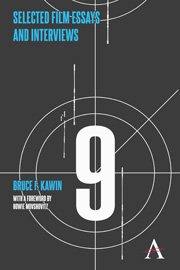Book contents
- Frontmatter
- Contents
- Foreword
- Preface
- PART I VIOLENCE AND POLITICS
- PART II HORROR AND SCIENCE FICTION
- PART III REVIEWS
- PART IV INTERVIEWS
- PART V LITERATURE AND NARRATION
- PART VI GETTING IT RIGHT
- 18 Creative Remembering and Other Perils of Film Study
- 19 Late Show on the Telescreen: Film Studies and the Bottom Line
- 20 Video Frame Enlargements
- 21 Three Endings
- Acknowledgments
- Index of Names and Titles
20 - Video Frame Enlargements
from PART VI - GETTING IT RIGHT
Published online by Cambridge University Press: 05 May 2013
- Frontmatter
- Contents
- Foreword
- Preface
- PART I VIOLENCE AND POLITICS
- PART II HORROR AND SCIENCE FICTION
- PART III REVIEWS
- PART IV INTERVIEWS
- PART V LITERATURE AND NARRATION
- PART VI GETTING IT RIGHT
- 18 Creative Remembering and Other Perils of Film Study
- 19 Late Show on the Telescreen: Film Studies and the Bottom Line
- 20 Video Frame Enlargements
- 21 Three Endings
- Acknowledgments
- Index of Names and Titles
Summary
I worked on this article, which was published in Film Quarterly in 2008, for five years. Every time the technology advanced, I had to make new trial stills. By the time I was ready to write up the results, Snappy had gone out of business and I had to start over with a new frame grabber. The original comparison was between black-and-white and color frames, using Citizen Kane and Vertigo. When the article was completed, however, the studio refused to allow the use of the Vertigo frame. So I shot the frame from Intolerance, which is in the public domain, and rewrote the article so that the comparison was between a close-up and a long shot. Explaining how to grab a frame took me back to the year I worked at IBM while I was in college, rewriting the programmers' draft of a long technical manual.
There used to be two ways to illustrate a book or article with pictures from a film: to photograph a frame enlargement from a 16mm or 35mm print or to select a production still that originally came from a press kit. Production stills, distributed for reproduction in magazines and newspapers, are posed and generally give sharp views of the sets and the actors in costume, and sometimes they approximate the blocking of actual scenes. For a literal view of what is onscreen for a fraction of a second, one needs a copy of an actual frame from the movie. A frame enlargement could be printed as a photograph and submitted to the publisher as an 8 × 10 or as a 35mm slide. Production stills, usually found in archives and in memorabilia stores, most often were 8 × 10s.
- Type
- Chapter
- Information
- Selected Film Essays and Interviews , pp. 187 - 195Publisher: Anthem PressPrint publication year: 2013



